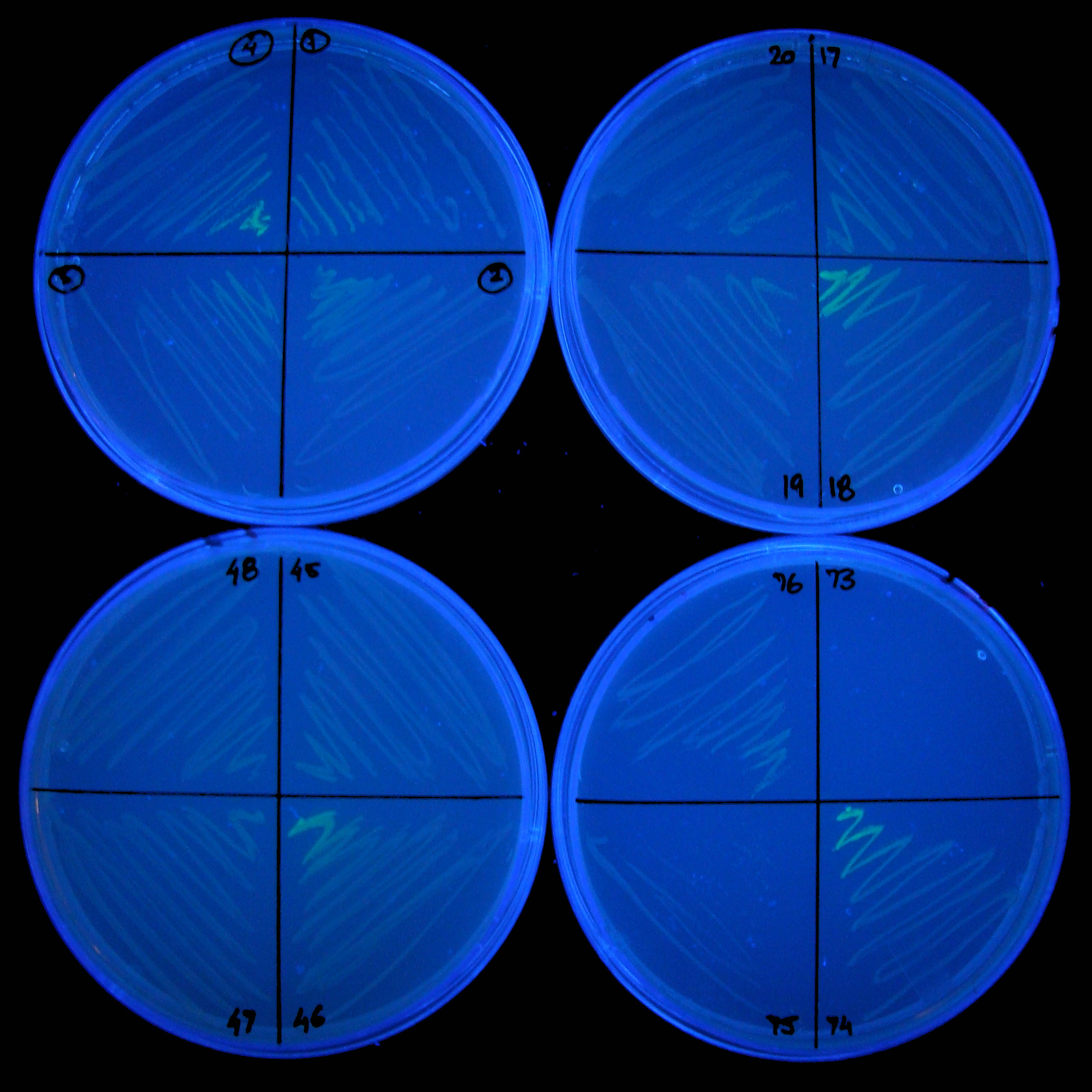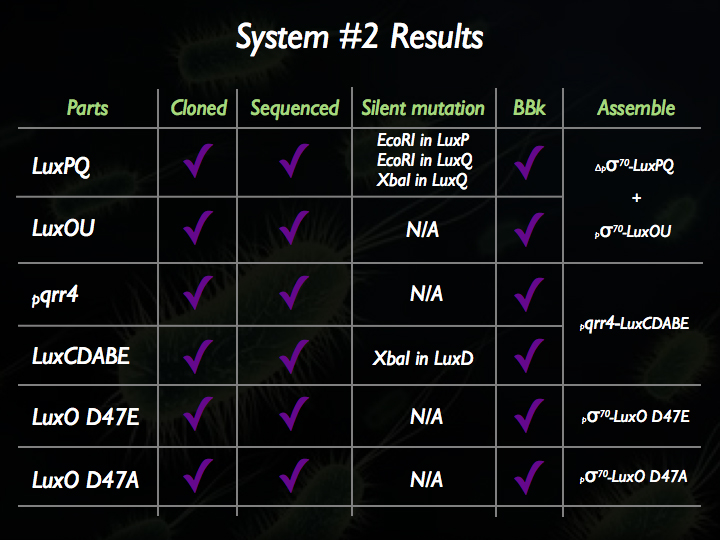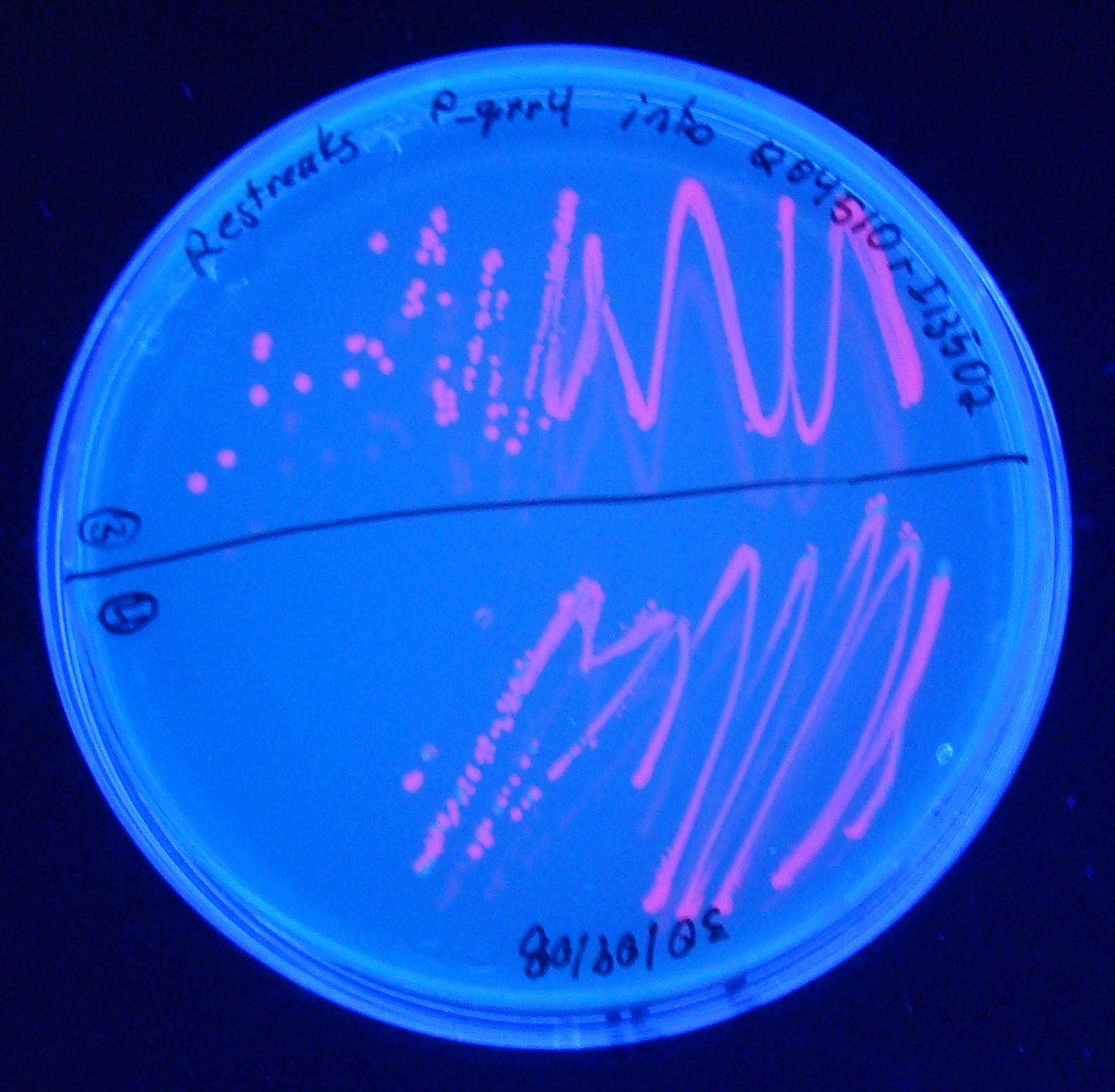Team:Calgary Wetware/Results
From 2008.igem.org
| Home | The Team | The Project | Notebook | Protocols | Results | Beyond the Lab | Parts |
|---|
The above image depicts the results obtained when testing a couple of intermediates of System #1 (i.e. AHL production by Bad Guy #1 and signal interception by our Champion Cell). Basically, we grew a lawn of our Champion cells containing an intermediate (F2620+I13500) in tandem with our Bad Guy #1 (containing the J23039 part) in order to see whether or not our culture of Bad Guy #1 was in fact producting AHL to which our champion cells could respond. A positive AHL control was used (AHL dissolved in Methanol and Ethyl Acetate). As can been seen by the very nice green halos, our Champion cells are able to respond to AHL by producing GFP (as seen in the control quadrants) and our Bad Guy #1 cells are making AHL to which our Champion cell is also responding!
In the image above, the following experiment was undertaken: Is the entire Biobricked ColicinE2 operon (under control of the SOS promoter) able to produce the cytotoxic colicinE2 when induced in E. coli?? Because expression of the ColE2 operon necessitates the activation of the SOS promoter (pSOS) brought on by the induction of the SOS response within E. coli, this state of crisis was initiated in the cells harboring this part using the DNA cross-linking agent Mitomycin C. This agent, however is not sufficient to allow for the expression of the ColE2 genes, as RecA (induced by the SOS response) must first cleave the lexA repressors binding to the operator region of pSOS. Unfortunately, as TOP10 E. coli (Our lab's little bugger of choice!) are mutants for RecA (i.e., do not express a functional RecA protein), the BL21 strain of E.coli (producing functional RecA protein) was transformed with the ColE2 part and induced with Mytomycin C. A portion the Mytomycin C induced BL21 culture was spotted on a lawn of growing E. coli constitutively expressing RFP (for visual effect) and zones of clearing were visualized. Finally, to ensure that it was ColicinE2 that was killing the lawn of RFP-bacteria and not some remnant Mitomycin C from the induced cultures, we spotted Mitomycin C dissolved in LB onto a quadrant of the plate and saw no clearing, indicating that we were able to induce ColE2 production using Mytomycin C and that ColE2 was capable of killing E. coli!! For further details on the characterization of the operation of Biobricked ColE2 operon, please refer to K131000.
This image illustrates the functioning of our final System #1 response circuit within our Champion cell. On each plate, we have several streaked colonies putative for containing the final System #1 circuit. AHL was spotted in the middle of the plate and colonies 4, 18, 46 and 47, show a clear response to this pheromone by producing GFP. While these cells were able to produce high enough levels of GFP to allow for visualization, these cells appear to have remained intact (i.e. were not lysed as expected upon expression of the ColE2 operon). What is likely happening is that while AHL is inducing producting of GFP and colicin within our champion cells, the level of the ColE2 lysis protein (involved in colicin release) hasn't reached high enough levels to destroy the cells. Thus, higher concentrations of AHL may be required for adequate expression of the ColE2 genes to allow for colicin release. This will continue to be investigated leading up to the jamboree.
This is our empty response circuit for the quorum signaling molecule, AI-2. This was to go into our champion cell, along with the sensing circuit for AI-2, which contains, under regulation, the protein necessary to activate this circuit, LuxO (BBa_K131016). When LuxO is dephosphorylated, which occurs when AI-2 is present, transcription stops from BBa_K131017, leading to no more cl lam, and hence no more repression on the cl lam promoter. Thus, RFP is produced only when AI-2 is sensed. This construct has no terminators, as our champion cell is intended to produce both RFP and colicin E3 (an antibiotic), however this intermediate allows any DNA to be expressed along with RFP, under control of AI-2.
 "
"





